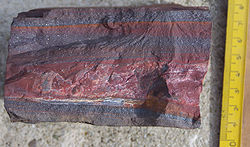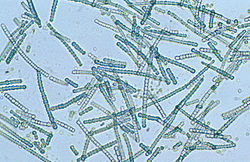Banded iron formation
Banded iron formations (or BIFs) are a distinctive type of rock often found in Precambrian sedimentary rocks.
They consist of repeated thin layers of iron oxides, either magnetite (Fe3O4) or hematite (Fe2O3), alternating with bands of iron-poor shale and chert.
Some of the oldest known rock formations, formed over 3,700 million years ago (mya), include banded iron layers.[1] The banded layers are a common feature in sediments for much of the Earth's early history.[2][3]
Relation to atmospheric oxygenation

The formations are abundant around the time of the Great Oxygenation Event, 2,400 mya.[4] They become less common after 1,800 mya.
The total amount of oxygen locked up in the banded iron beds is estimated to be perhaps twenty times the volume of oxygen present in the modern atmosphere of Earth. Banded iron beds are an important commercial source of iron ore, such as the Pilbara region of Western Australia, the Animikie Group in Minnesota and Carajás Mineral Province in Brazil.[5]
Origins
The conventional concept is that the banded iron layers were formed in sea water as the result of oxygen released by photosynthetic cyanobacteria. This combined with dissolved iron in Earth's oceans to form insoluble iron oxides. These precipitated out, forming a thin layer on the substrate, which may have been anoxic mud (forming shale and chert). Each band is similar to a varve: the banding is assumed to result from cyclic variations in available oxygen.
It is assumed that the Earth started out with vast amounts of iron dissolved in the world's acidic seas.[6] Iron is much more soluble than its oxides.
Eventually, as photosynthetic organisms generated oxygen, the available iron in the Earth's oceans was precipitated out as iron oxides.
At the tipping point where the oceans became permanently oxygenated, small variations in oxygen production produced pulses of free oxygen in the surface waters, alternating with pulses of iron oxide deposition.
Banded Iron Formation Media
Banded iron formation from the Barberton Greenstone Belt, South Africa
Thin section of Neoproterozoic banded iron formation from Australia
Abundance of banded iron formation in the geologic record. Color indicates dominant type. Red = older Archean formations; green = Greater Gondwana formations; blue = granular iron formations; black = Snowball Earth formations. Adapted from Trendall 2002.
A burn in Scotland with iron-oxidizing bacteria
Oxygen (O2) build-up in the Earth's atmosphere. Red and green lines represent the range of the estimates while time is measured in billions of years ago (Ga).*Banded formation iron deposition peaks at the beginning of Stage 2 and pauses at the beginning of Stage 3.
References
- ↑ Minik T. Rosing et al. 1996. Earliest part of Earth's stratigraphic record: A reappraisal of the >3.7 Ga Isua (Greenland) supracrustal sequence. Geology 24 #1, 43-46
- ↑ Knoll, Andrew H. 2004. Life on a young planet: the first three billion years of evolution on Earth. Princeton, N.J. ISBN 0-691-12029-3
- ↑ Faces of Earth - Building the Planet. YouTube account of early Earth history. [1] American Geosciences Institute.
- ↑ Cloud, Preston 1973. Paleoecological significance of the Banded Iron-Formation. Economic Geology 68 (7): 1135. doi:10.2113/gsecongeo.68.7.1135.
- ↑ DOCEGEO, 1988, Revisão litoestratigráfica da Província Mineral de Carajás: Congresso Brasileiro de Geologia, 35th, Sociedade Brasileira de Geologia, Belém, Brazil, p. 11−54.
- ↑ Cesare Emiliani, Planet Earth 1992:407f, and Tjeerd van Andel, New Views on an Old Planet 2nd ed. 1994:303-05.








